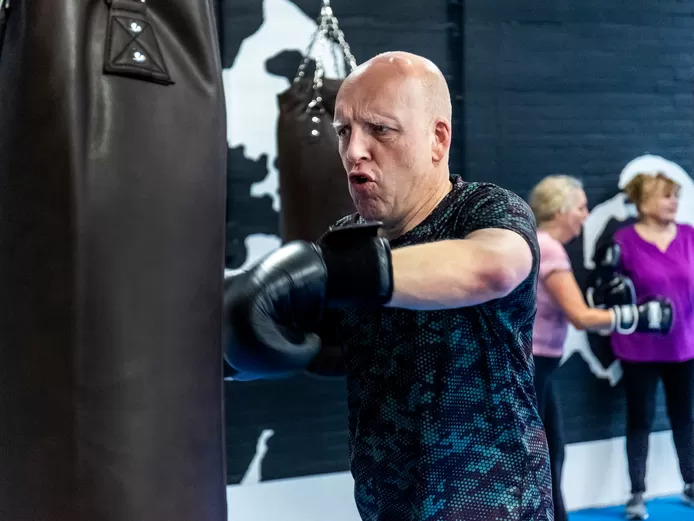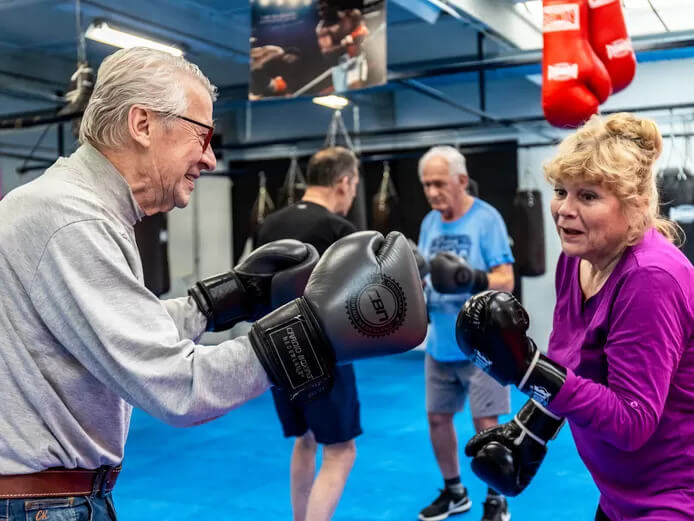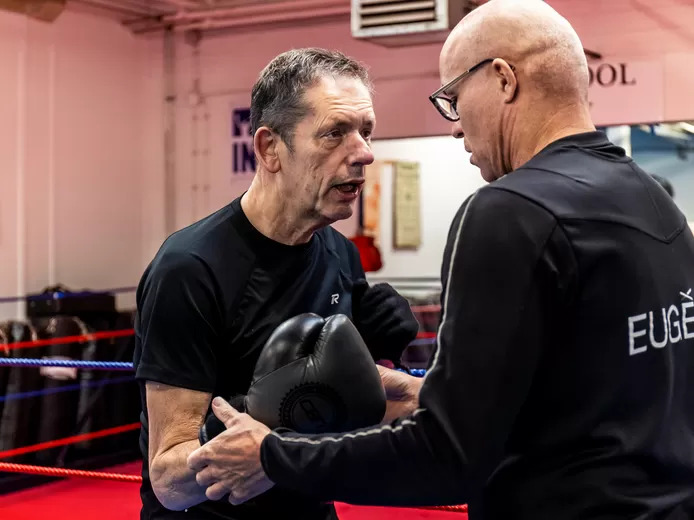
- Inspiring People -
- 8mins -
- 1,407 views
How boxing and Parkinson’s go hand-in-glove
Exercise can help manage the different symptoms of Parkinson’s Disease to help you regain control of your life, and while there’s no one-size-fits-all approach to a fitness regimen, many people who live with PD have been turning to boxing exercise — with knockout results!
Boxing and Parkinson’s disease
At first sight an unexpected combination, but according to neurologists the perfect match. "With people with Parkinson’s, two things go wrong at the same time and that is exactly what you can train with boxing: balance, punches and strength." Sedney’s boxing school in Zeist, Netherlands, gives boxing lessons to Parkinson’s patients.

The boxers come from all around for their regular Tuesday morning bouts
It is 10:50 am when the boxers trickle in one by one. It is pouring rain outside, but many participants still came by bicycle. For many of them, it is a regular Tuesday morning, a nice game of boxing with Eugene Sedney (56). They come from all corners of the province: Woerden, Maarssen, Utrecht and Amersfoort. Brought together by that nasty disease they all struggle with.
Andreas Rosenberg (52) from Zeist was the first to enter here five years ago. Together with his buddy Teus, who also has Parkinson’s, they stood at the exact same counter opposite boxing gym owner Eugene. I asked: “May I come boxing with you?”
He immediately said: “I have Parkinson’s”. I said, “I don’t care what you have, go ahead and join in," Sedney added. “Of course I noticed a difference with those two boys, especially when they had to switch from punching the punching bag to abdominal exercises. They were less able to follow the lesson, but they did have a great time.”
Don’t think long
That got the former amateur boxer thinking. “Andreas said: if I’ve boxed with you, I can tie my shoelaces at home again, put on my shirt, I finally feel good again. Then you don’t have to think long, do you? And so I went into it and saw that there was a boxing gym in Ede that offers these classes especially for people with Parkinson’s. I followed a course with them and then I said to Andreas and Teus: if you are the only two in six months, then we will stop.”
But within a few months there were already eight Parkinson’s boxers on his mat. All forwarded by their physiotherapists and by each other. “It went like wildfire. And you’ll see: I really don’t treat them any differently. I’m not going to be childish, they just have to work hard. Because that’s what it is, they are no longer challenged because everyone takes them into account, but here they are equals.”
Source: deGelderlander.nl

Skipping rope
It’s 11 a.m. Sedney claps his hands and the fourteen boxers walk into the room. On the wall are photos and posters of the famous boxer Muhammed Ali and in the back of the room the famous boxing ring. A nice up-tempo music is turned on, a beep sounds. Part of the group starts with jumping rope and a group runs circles between the punching bags.
After a short warm-up, the boxing gloves are put on and the real work can begin. A duo that immediately stands out is the couple Henk (77) and Alide (71) Gaasenbeek. Henk has Parkinson’s, Alide does not. And yet they come to boxing class together every week.
Alide fanatically slaps her husband’s gloves. "Left, right, corner, corner," she says aloud. Henk, who occasionally loses his balance and has to hold on to the ropes, willingly lets his wife beat him. "Only here!"

Move, move, move! That’s what I always hear. Well I definitely do here. — Hans Vonk
Difference
By coming to the boxing every week, they encourage each other to exercise, says Alide. “And I always notice a difference when we are at home. Then he feels very satisfied. He then also feels energetic for the rest of the day.” After half an hour, however, Henk gives up. “Last week I lasted the whole lesson. Today it is not possible.”
Hans Vonk (62) from Woerden never expected that he would ever end up in a boxing gym, he says when he is allowed to rest between the boxing. The first beads of sweat collect on his forehead.
“I hated boxing, always zapped by it when it was on TV. But luckily we don’t have to punch each other in the face. I went with someone from the Parkinson’s club once and now I don’t skip training. Move, move, move. That’s what I always hear. Well, I certainly do here.”
He always feels better after an hour of boxing. “Mentally and physically. It’s just lovely and the group is great fun too. Before corona, we always went for a cup of coffee after class.”
‘It helps’
Above the thumps on the gloves is Sedney’s loud voice. He calls out new combinations, encourages them, walks through them to help them. Andreas, the very first boxer in his gym, has a bit of trouble with the movements.
“I took a break for two years because of an operation, this is my very first time. I hesitated for a long time, but now that I’m at it again I don’t understand why. Even though I sometimes get completely stuck, it’s so nice to be busy. After such a training, I walk better and I have less leg cramps. So yes, it really helps.”
Source: deGelderlander.nl

Exercising releases dopamine, which is exactly the substance that people with Parkinson’s lack
Such a group also entails a lot, according to Sedney. “You really build a relationship with them. I see them gradually deteriorate, but I see when they are having a good day. Sometimes they don’t come for a long time and then I know what time it is, and sometimes they never come again. Fortunately, that has only happened to me once in all that time, that one of our boxers died of the disease. Yes… that’s tough.”
To squeeze the last bit of energy from his boxers, they are allowed to go wild on the punching bag for a few minutes. "Blowing!" shouts Sedney. And they do. Tired but satisfied, they then puff out against the wall. “Until next week!" they call to each other as they walk out the door sweaty.
Boxing releases dopamine
Marlies van Nimwegen, expert physiotherapy at the ParkinsonNet coordination center at Radboudumc, can explain why boxing and Parkinson’s disease are not a crazy combination. “In people with Parkinson’s disease, two things go wrong at the same time and that is exactly what you have to do with boxing: balance, punches and strength. Exercise in any form is very important for people with this disease. Exercising releases dopamine, which is exactly the substance that people with Parkinson’s are deficient in.”
Due to the lack of substances such as dopamine, people with Parkinson’s become stiffer and slower. "It is a very complex disease that manifests itself in many ways, such as walking more slowly and leaning forward, shaking, but also thinking more slowly and speaking more difficult."
“Fortunately, there is a lot of attention for it and more research is being done. As a result, we always know a little more.” — Marlies van Nimwegen, Expert physiotherapy at Radboudumc
The book De Parkinsonpandemie by neurologist Bas Bloem was recently published. “Currently, 60,000 Dutch people have the disease. But the disease is becoming more common and is only expected to increase in the coming years. It is the fastest growing brain disorder. This is because we are getting older and because the disease is caused by aging in the brain.”
But there is also another reason, explains Van Nimwegen. “More and more studies show that our environment also plays a role, such as the pesticides in agriculture to which farmers are exposed, but which we also ingest through our food. It is often still unclear what the exact cause is. Fortunately, there is a lot of attention for it and more research is being done. As a result, we know a little more and more.”
Editor’s note: This article has been translated from Dutch. The original was written by Rachel van Kommer for de Gelderlander.
Source: deGelderlander.nl
What is Parkinson’s Boxing?
While you might have heard of Parkinson’s boxing classes you may not know exactly what they entail and what symptoms it can help alleviate.
What is a Parkinson’s Boxing Class?
A Parkinson’s boxing class is a full-body workout exercise regimen where you perform non-combat boxing exercises. A typical Parkinson’s boxing class will involve:
- Anywhere from 30 – 60 minutes of exercises
- Stretches and warm-up exercises to prepare the body for the workout and to avoid injury.
- Punching speed bags to help improve coordination and posture or punching heavy bags to build strength and muscle.
- Vocal exercises are incorporated into the workout to help with any voice disorder symptoms of Parkinson’s.
- Footwork and other agility exercises will be used to help improve balance.
- There is also a lot of group exercises that focus on socialisation and community in each class.
If you would like to see a Parkinson’s boxing class in action click here.
What are the benefits of a Parkinson’s Boxing Class?
The benefits associated with a Parkinson’s boxing exercise regimen include:
- Increased strength
- Improved hand-eye coordination
- Improved posture
- Better cognitive processing
- Relieve symptoms for soft-voice disorders
- Stronger core which can lead to a better gait
- Improved balance and agility
- Improved reaction time
FAQ’s for Parkinson’s Boxing classes
Should I ask my doctor before attending a class?
- You should always consult your doctor before starting up any new intense exercise regimen to make sure that it will be beneficial to you.
Do I need to bring my own boxing gloves?
- Boxing gloves are provided at locations although many participants like to bring their own customised gloves.
Will I be fighting other people?
- No, the classes are non-combat which means you will not be punching or be punched by, another person.
How intense is the class?
- The class intensity can vary depending upon the instructor, but the average intensity is more than most seated Parkinson’s exercise classes.

